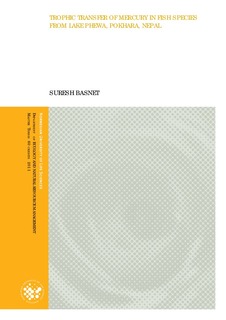| dc.description.abstract | This study represents the first attempt to quantify concentrations of mercury and its trophic transfer along the food chain, in one of the lakes in Nepal, Lake Phewa. Stomach content analysis and stable isotopes of nitrogen (δ15N) and carbon (δ13C) were used as an index of trophic level and carbon source and were used to study bioaccumulation and biomagnifications of mercury in Nile Tilapia (Oreochromis niloticus), African magur (Clarias gariepinus), Sahar (Tor putitora) and Chuche Baam (Mastacembelus armatus) . Metal concentration in water and in the gill and liver of these fish species were examined. Muscles samples of the largest among each species were analyzed to identify the concentration of Persistant Organic Pollutants (POPs).
The diet of O. niloticus were dominated by aquatic plants, regardless the size, whereas in other three species, aquatic insects, crustacea, fish were dominated in the diet. The mean and maximum value of total mercury (THg mg kg-1 w.w.) concentrations were 0.071 and 0.32 for C. gariepinus, 0.031 and 0.081 for O. niloticus, 0.116 and 0.21for T. putitora and 0.079 and 0.22 for M. armatus. The relationship between THg and total length and total weight were positive and significant in C. gariepinus and M. armatus. Age determination could not be done for any of the fish species. For none of the species, the value of δ15N and δ13C correlates with the total length of the fish, possibly because of few isotope analysis. The relationship between log THg and δ15N were with the present analysis, not significant for any of the species indicating no biomagnification. Since the THg level in all the fish species was consistently low, it will not pose any harm to the fish consuming community. In the food chain, M. armatus hold the top position and O. niloticus the bottom. Metal analysis of water, gill and liver showed the exposure of fish species to various trace metals. Except for high levels of manganese (Mn), the values were comparable to levels found in other lake and river system in Europe. Metabolites of DDT and Endosulfan sulfate were found in the muscle sample of fish, but at levels of low concern by the present regulations.
The present study represents only 4 out of nearly 30 species so far registered in Lake Phewa. Further studies on Hg and pesticides in the most important fish species in Lake Phewa, as well as in the other lakes in the region, should be facilitated to improve risk assessment and enable a proper management in relation to pollutants in the fish populations of the lakes. | en_US |
